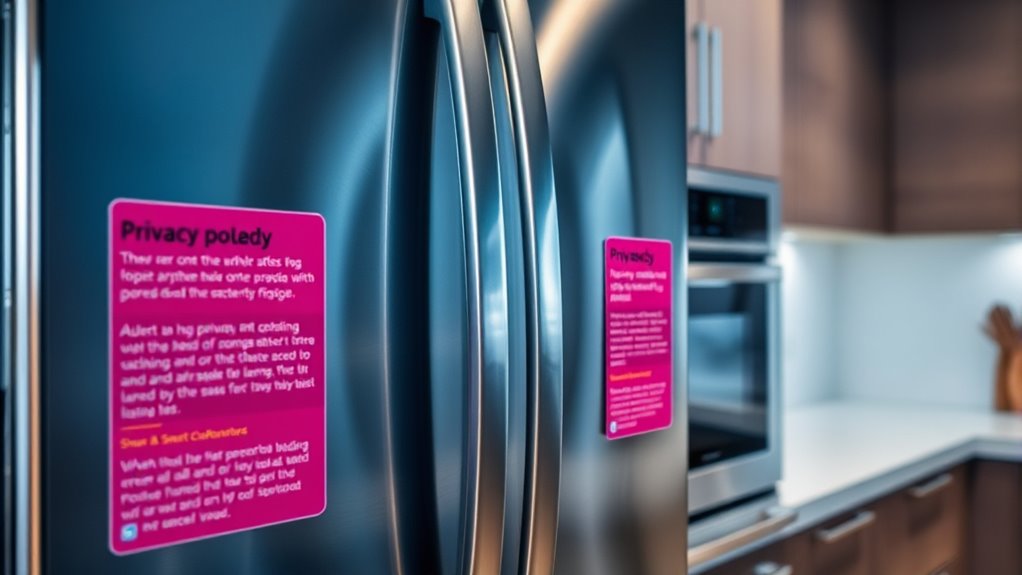Privacy labels on connected appliances reveal how they collect, use, and safeguard your data. They show if personal info like location or usage patterns are gathered, detail security practices, and highlight industry certifications. QR codes give quick access to detailed policies and certification info. These labels help you understand your device’s privacy practices and guarantee transparency. Keep exploring, and you’ll discover how to better protect your privacy and make informed choices about your appliances.
Key Takeaways
- Privacy labels disclose data collection practices, including personal identifiers, sensor data, and transmission methods like Wi-Fi or Bluetooth.
- QR codes provide quick access to detailed privacy policies, security certifications, and data handling disclosures.
- Labels highlight security measures such as encryption standards, industry certifications, and device vulnerabilities or protections.
- They specify data retention periods, user controls, third-party sharing, and security protocols to ensure transparency.
- Future trends focus on customizable privacy settings, automatic data deletion, advanced encryption, and AI-driven security enhancements.
Understanding Privacy Labels: What They Reveal About Your Devices
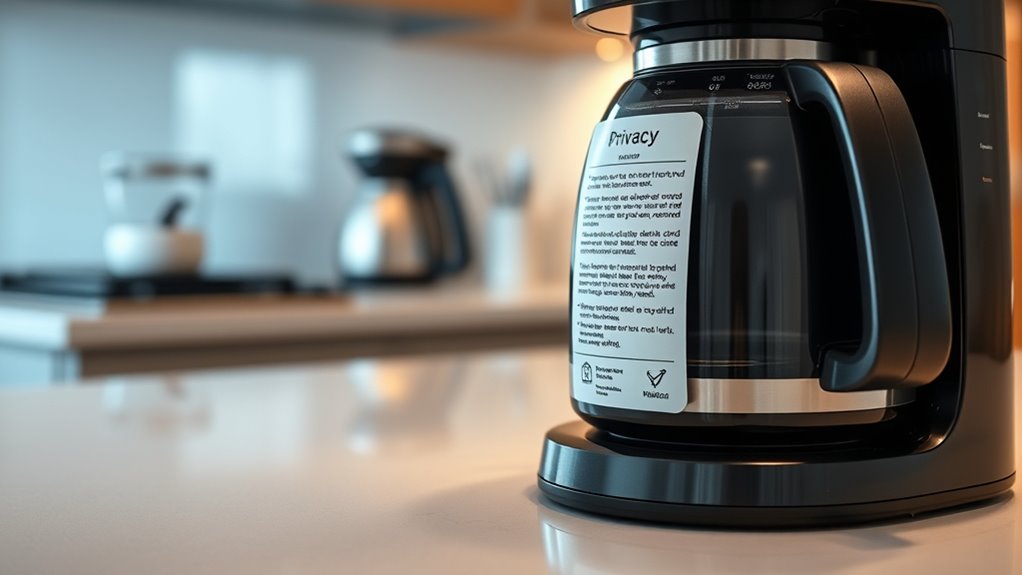
Understanding privacy labels is essential because they reveal what your connected appliances are doing behind the scenes. These labels disclose whether your device collects personal or anonymous diagnostic data, specifying types like power status, cycle details, or filter information. More invasive data, such as ZIP codes, phone numbers, or geolocation, may also be included, especially via linked smartphone apps. Privacy labels highlight if data is shared with third parties or tracked by embedded sensors in apps. They provide details about opt-in or opt-out options, giving you control over your information. Additionally, labels list all sensors, such as audio, video, motion, or environmental ones, alerting you to potential privacy risks. This transparency helps you understand how your appliance gathers and handles your data and the increasing prevalence of IoT devices amplifies these privacy concerns. Being aware of data collection practices empowers you to make informed decisions about your connected appliances. Recognizing the types of data collected can further help you assess the potential privacy implications of your devices.
Key Elements of Connected Appliance Disclosures
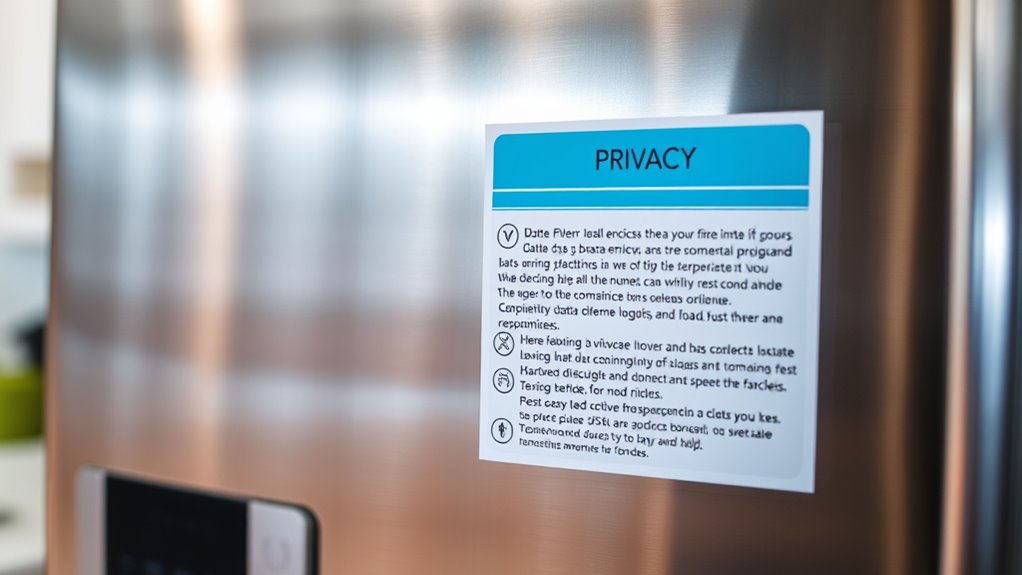
When comparing connected appliances, it’s vital to pay attention to their disclosures, which detail key privacy and security features. These disclosures must clearly indicate whether cameras or microphones are embedded, even if hidden. You should see information about data transmission methods, like Wi-Fi or Bluetooth, and what data is collected, such as usage patterns or audio recordings. Disclosures also cover data retention periods and security measures to protect stored information. Additionally, they must specify if data is shared with third parties, including advertisers or service providers. Consumer control features are fundamental—you should be able to disable or opt out of data collection where possible. Clear communication about location data use and encryption status during transmission helps you understand your privacy rights and device security. Moreover, the disclosures should include information about foreign ownership that could impact data privacy and security. Being aware of data encryption practices can help you better assess the security of your connected devices, and understanding the privacy certification can guide you in choosing more trustworthy products.
Navigating Data Collection and Security Practices
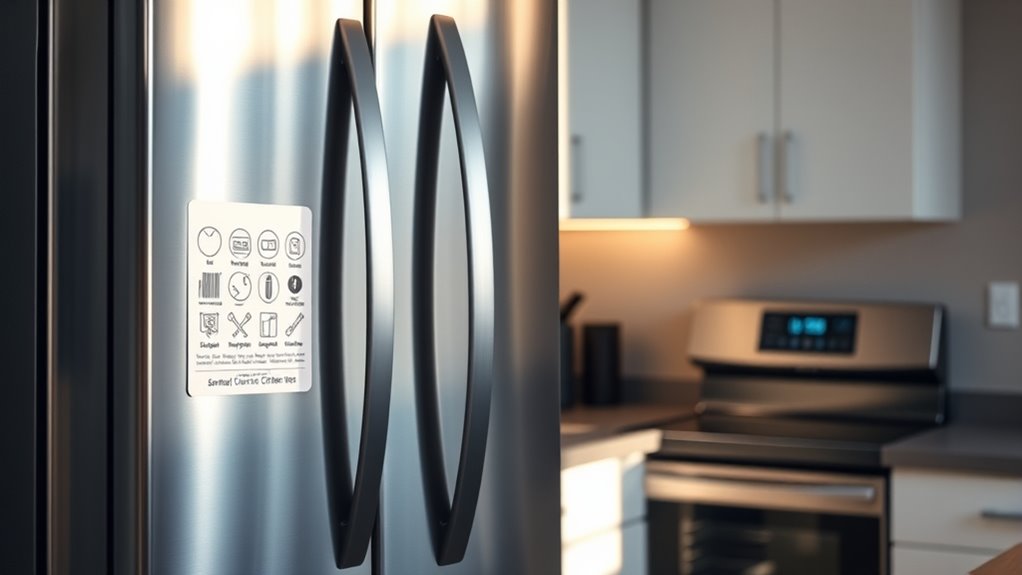
Understanding what data your connected appliances collect helps you make informed decisions about your privacy. Many devices track usage details and personal information, while security measures like encryption can protect your data during transmission. However, knowing how these practices work and where vulnerabilities exist is key to safeguarding your home. For example, Pimple Patch technology can include embedded sensors or ingredients that enhance efficacy but may also be part of the data collection process. Being aware of data collection practices helps you better evaluate the privacy implications of your devices.
Data Types Revealed
Connected appliances collect a wide range of data to enhance functionality and user experience, but it’s important to know what types of information are being gathered. They track usage data like power status, door actions, temperature settings, and energy consumption to monitor performance and optimize service. Personal identifiers, such as ZIP codes, phone numbers, birth dates, and geolocation, are often collected to connect devices and personalize services. Sensor data captures environmental conditions like humidity, light, and CO2 levels, as well as behavioral patterns inferred from sensor fusion. Additionally, smartphone apps linked to appliances may gather data through third-party trackers, which can include app usage and device activity. This exhaustive data collection helps improve product features but also raises privacy considerations regarding how your information is disclosed and used. Understanding the scope of data collection practices is essential for maintaining privacy security. Preppy dog names can sometimes serve as inspiration for personalized device profiles or custom labels, reflecting the importance of unique identifiers in privacy settings.
Security Measures Explained
To keep your smart appliances secure, it’s vital to understand the security measures in place to protect your data during collection and transmission. End-to-end encryption is recommended to guarantee your data stays confidential from device to server. Encrypted communication between appliances and apps helps prevent unauthorized access and maintains data integrity. However, some devices lack proper encryption, exposing sensitive info to interception. Using secure network protocols like TLS is essential to prevent data leaks during transfers. Regular security updates are necessary to fix vulnerabilities found after deployment. You should also set strong, unique passwords for each device and enable network segmentation, isolating IoT devices from other systems. Disabling unnecessary features, such as remote access, can further reduce attack surfaces and enhance your device’s security. Additionally, understanding AI security vulnerabilities can help you make more informed choices about connected appliances. Incorporating security best practices based on the latest industry standards can further strengthen your defenses against cyber threats.
The Role of QR Codes in Consumer Access to Privacy Information

QR codes on connected appliances provide a quick way for you to access privacy information without searching manuals or websites. Scanning these codes instantly shows you security details, data collection practices, and privacy settings. This simple tool promotes transparency and keeps you engaged with your device’s privacy and security features.
Easy Access Point
QR codes are increasingly used as quick, simple access points for consumers to obtain detailed privacy information about appliances. When you scan these codes, you’re directly linked to privacy disclosures, data collection practices, and security tips. These codes are often printed on model tags, labels, or packaging, making privacy details easily accessible without searching websites or user manuals. They help overcome the challenge of small or unclear markings on devices. Consumers benefit from:
- Instant access to privacy policies and data handling info
- Clear links to security and update policies
- Notifications about third-party trackers and permissions
- Easy retrieval of maintenance and data collection disclosures
- Facilitates understanding of juice cleansing practices and their impact, helping consumers make more informed decisions about their health and wellness routines. Additionally, they can provide insights into how your connected appliances collect and utilize your data, promoting transparency and trust. This streamlined approach promotes transparency, empowers you to make informed decisions, and simplifies understanding of how your appliances manage data.
Instant Security Details
How do connected appliances quickly assure you of their security standards? QR codes provide instant access to detailed privacy disclosures, so you don’t need to navigate complex menus or websites. When you scan a QR code, it immediately reveals data use practices, what personal data is collected, and how it’s processed. These codes also link to updated privacy policies, reflecting real-time changes in data handling. They let you verify security certifications and compliance statements specific to the appliance. Plus, QR codes help you quickly access information about encryption standards, authentication protocols, and data retention policies, ensuring your data’s protection. Secure data practices are often summarized through these codes, allowing consumers to make informed decisions. This instant access builds trust, confirms security measures, and reassures you that your privacy is a priority. Additionally, the privacy labels displayed via QR codes can assist in comparing different appliances’ security features at a glance.
Promotes Transparency Engagement
Connected appliances utilize QR codes not just for quick access to security details but also to foster ongoing engagement with privacy information. These codes enable you to explore detailed disclosures, including data collection policies and third-party tracking. They also facilitate real-time updates, offering tailored privacy and maintenance info over time, which deepens your understanding of data use and protections. Additionally, QR codes simplify onboarding by linking you directly to privacy details during setup, often with automatic product data linking. They support regulatory efforts and voluntary labels by providing transparent security and privacy info, empowering you to make informed decisions. This dynamic access promotes continuous awareness, allowing you to verify what data is collected and how it’s used, ultimately enhancing your control over personal information. Incorporating self-awareness into your interaction with these disclosures can further improve your understanding of personal data management. Furthermore, these tools can help you develop a privacy-conscious mindset, encouraging more mindful interactions with connected devices.
How Industry Standards and Certification Influence Labeling
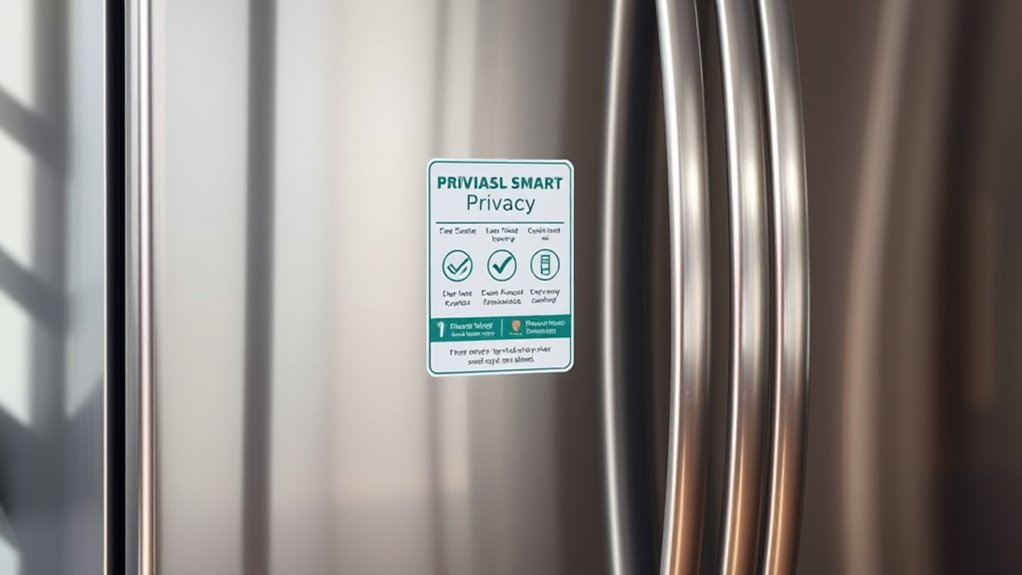
Industry standards and certification programs play a pivotal role in shaping the transparency and trustworthiness of privacy labels on connected appliances. These standards, like the CSA PSV Mark, TÜV Rheinland certification, and Eurosmart IoT Scheme, set clear security and privacy benchmarks. They require devices to have unique identities, secure data storage, and effective communication protections, which are often highlighted on labels via QR codes or URLs. Certifications such as TrustArc, ISO, and IEC verify organizations’ compliance with privacy laws and security best practices, often reflected in labeling. Regional regulations like CE marking and IMDA standards confirm conformity with local safety and privacy requirements. By adhering to these standards, manufacturers demonstrate their commitment to data protection, making labels more reliable and informative for consumers.
Future Trends in Appliance Privacy and Security Transparency
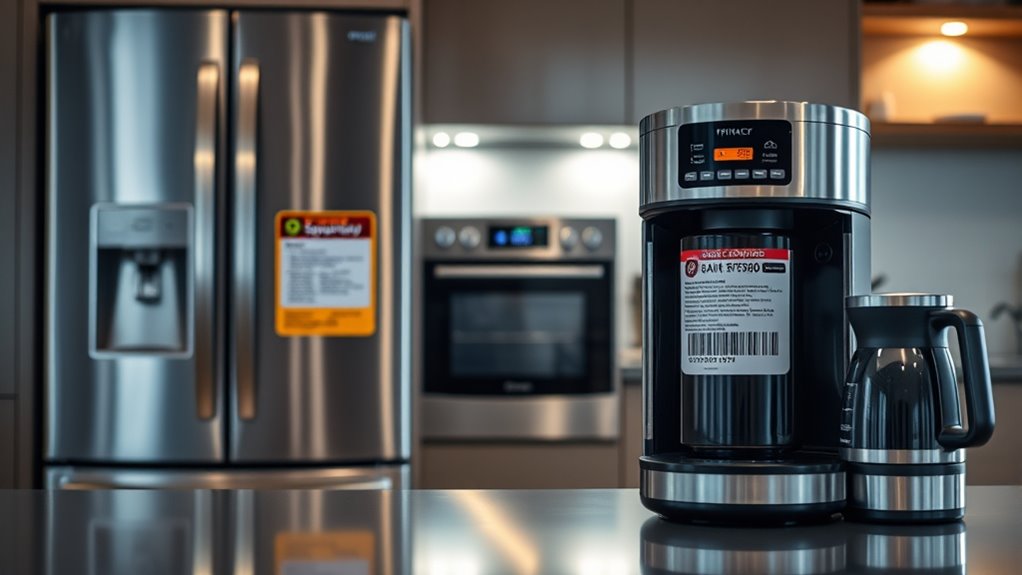
As technology advances, appliance manufacturers are increasingly prioritizing transparency and user control over personal data. Future trends focus on empowering you with customizable privacy settings, such as choosing what data to share, with whom, and for how long. You’ll gain features like automatic deletion of historical data and dynamic privacy policies enabled by smart contracts. Transparency will improve, clearly explaining data management practices and fostering accountability. Additionally, AI and machine learning will play a major role in proactive security measures, detecting threats early and processing data locally to preserve privacy. Enhanced encryption and authentication protocols, including biometrics and blockchain, will secure your devices. Despite these advancements, many consumers still lack understanding of data practices, highlighting the need for ongoing education and clearer disclosures. Incorporating vertical storage solutions can help manage data more efficiently and securely, supporting these privacy goals. Furthermore, ongoing regulatory developments will likely influence how manufacturers implement and communicate these privacy features.
Making Informed Choices: Using Privacy Labels to Protect Your Privacy
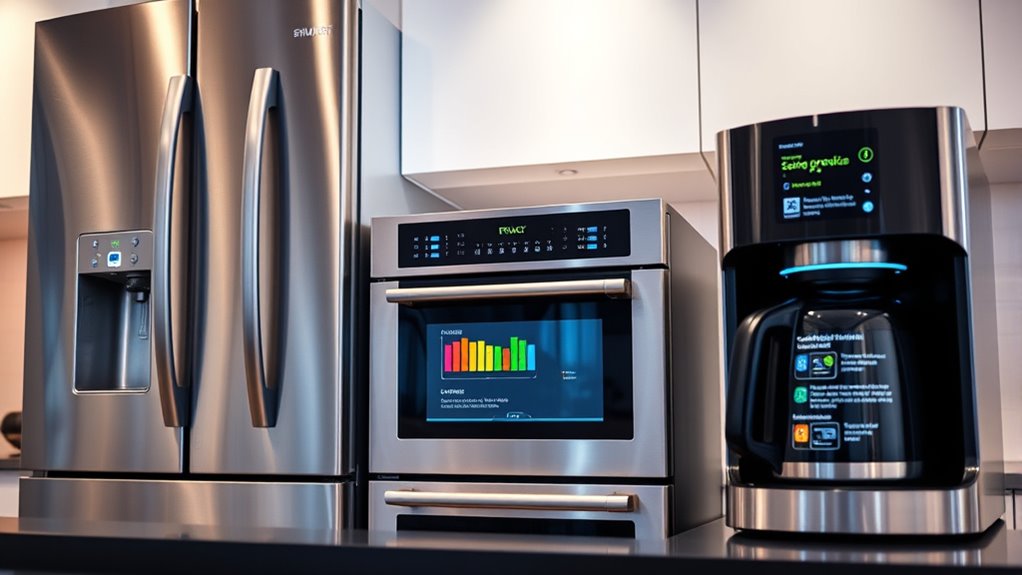
Privacy labels serve as a vital tool to help you understand what personal and usage data your appliances collect and share. By examining these labels, you can see if devices gather information like geolocation, power status, or personal identifiers such as ZIP codes and phone numbers. Look for disclosures about third-party trackers in companion apps, as they can collect additional data beyond manufacturer disclosures. Check if sensors like audio, video, or motion are included, and note the connectivity protocols used, such as Wi-Fi or Bluetooth, which influence data transmission. Using this information, you can compare devices, avoid those with excessive or unnecessary data collection, and make smarter choices. Clear, detailed labels empower you to protect your privacy and select appliances aligned with your comfort level. Additionally, understanding cookie policies can help you recognize how your data may be tracked during online interactions related to these devices. Being aware of privacy regulations can further inform your decisions and help ensure your rights are protected.
Frequently Asked Questions
Are Privacy Labels Legally Mandated or Voluntary for Manufacturers?
You should know that privacy labels for connected appliances are currently voluntary for manufacturers. While some industry programs, like the FCC’s IoT cybersecurity label, encourage transparency, there’s no law requiring them yet. Future legislation might make these labels mandatory, but for now, companies can choose whether to disclose privacy information. Staying informed about these developments helps you understand how much control and transparency you can expect from appliance makers.
How Often Are Privacy Labels Updated With New Security Information?
Privacy labels are updated based on various factors, but since the program is voluntary, updates may be inconsistent and depend on manufacturers’ choices. You should expect updates to occur when new security or privacy information becomes available, especially if regulations or industry standards push for more frequent disclosures. However, without mandatory rules, it’s possible that some labels remain static, so stay informed by checking for the latest updates regularly.
Can Privacy Labels Guarantee Complete Security of My Connected Appliances?
You can’t rely on privacy labels for complete security. They mainly offer transparency, not guarantees, and can’t prevent vulnerabilities from emerging after purchase. Cyber threats evolve, and software updates may be insufficient. Plus, labels often lack standardization and don’t cover all risks, especially from third-party apps or network exposure. So, while helpful, these labels shouldn’t be your sole security assurance—stay vigilant and keep software updated.
Do Privacy Labels Cover Only Data Collection or Also Data Sharing Practices?
Privacy labels cover both data collection and sharing practices, but they often lack details. You’ll find information on what data is collected, like usage or location, and sometimes on how that data is shared with third parties. However, they rarely specify which entities receive your data or the full scope of sharing, making it hard for you to fully understand how your information flows beyond the appliance itself.
How Do Privacy Labels Differ Internationally Across Different Countries?
You’ll find that international privacy labels differ markedly in strictness and structure. Countries like Finland and Singapore use layered, multi-level schemes with varying inspection rigor, while Germany relies more on self-declaration. Labels disclose data types, update periods, and security features, but the details and enforcement vary regionally. These differences reflect local privacy laws, trust levels, and regulatory standards, making global harmonization a key goal to improve clarity and consumer protection worldwide.
Conclusion
By decoding privacy labels, you gain the power to make smarter choices about your connected appliances. While some claim labels are just marketing tools, evidence suggests they do influence consumer behavior and push companies toward better security practices. By staying informed and questioning disclosures, you can better protect your privacy in a world of smart devices. Trusting these labels isn’t foolproof, but it’s a step toward more transparent, secure technology that works for you.
